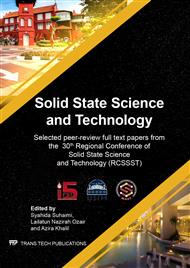p.64
p.70
p.78
p.84
p.93
p.98
p.104
p.113
p.119
Electrospinning Synthesis of Bi-2223 Superconducting Nanowires
Abstract:
This paper presents the synthesis and characterization of Bi2Sr2Ca2Cu3O8+x superconducting nanowires. Bi2Sr2Ca2Cu3O8+x nanowires with Tc = 68 K were synthesized using the electrospinning process employing sol–gel precursors. A sol–gel methodology was used to obtain a homogeneous PVP solution containing Bi, Sr, Ca, and Cu oxalates. Samples were heat-treated at 120 °C to remove excess moisture, and then at 850 °C in box furnace. Bulk sample was also prepared using coprecipitation method for comparison. Based on XRD, the nanowire sample showed minimal Bi-2223 phases and apparent Bi-2212 phases. The morphology, microstructure, and crystal structure of these nanowires were examined using field emission scanning electron microscopy (FESEM) to reveal a rectangular morphology having typical wire thickness in the range of 150–1000 nm. Electrospun Bi-2223 were grinded and pressed at 0.9 GPa into pellets. DC measurements were conducted to investigate the critical transition temperature (Tc) of Bi-2223 nanowires and to compare their magnetic properties to those of coprecipitated Bi-2223 pellets. The Tc for the bulk sample is observed at 101 K and electrospun Bi-2223 at 68 K. Coprecipitated Bi-2223 was added with Pb whereas electrospun Bi-2223 does not employ Pb. These results point to the existence of utilizing of the substitution of Pb with Bi; Bi-2223 phases in pressed nanowire are less, and the potential of using electrospinning to synthesis functional Bi-2233 superconductors.
Info:
Periodical:
Pages:
93-97
Citation:
Online since:
July 2020
Keywords:
Price:
Сopyright:
© 2020 Trans Tech Publications Ltd. All Rights Reserved
Share:
Citation:


